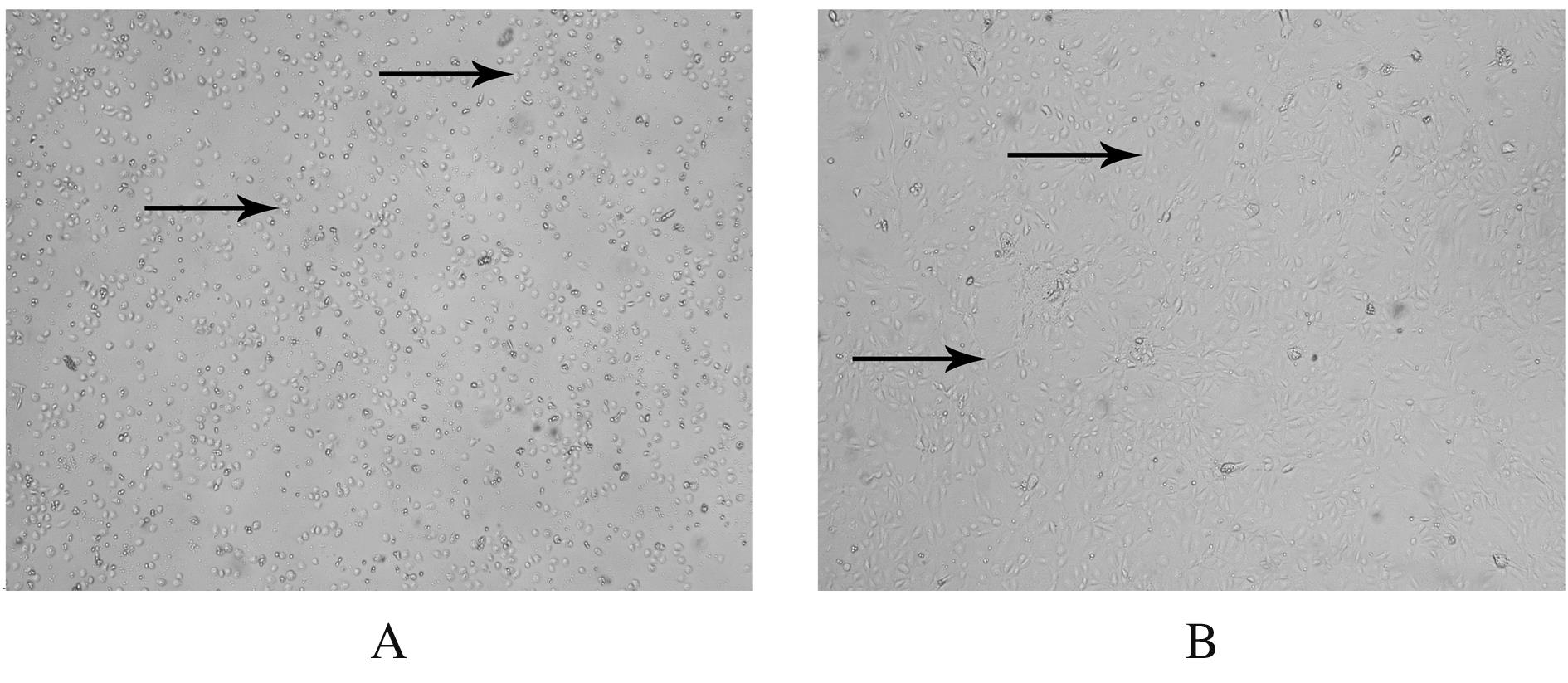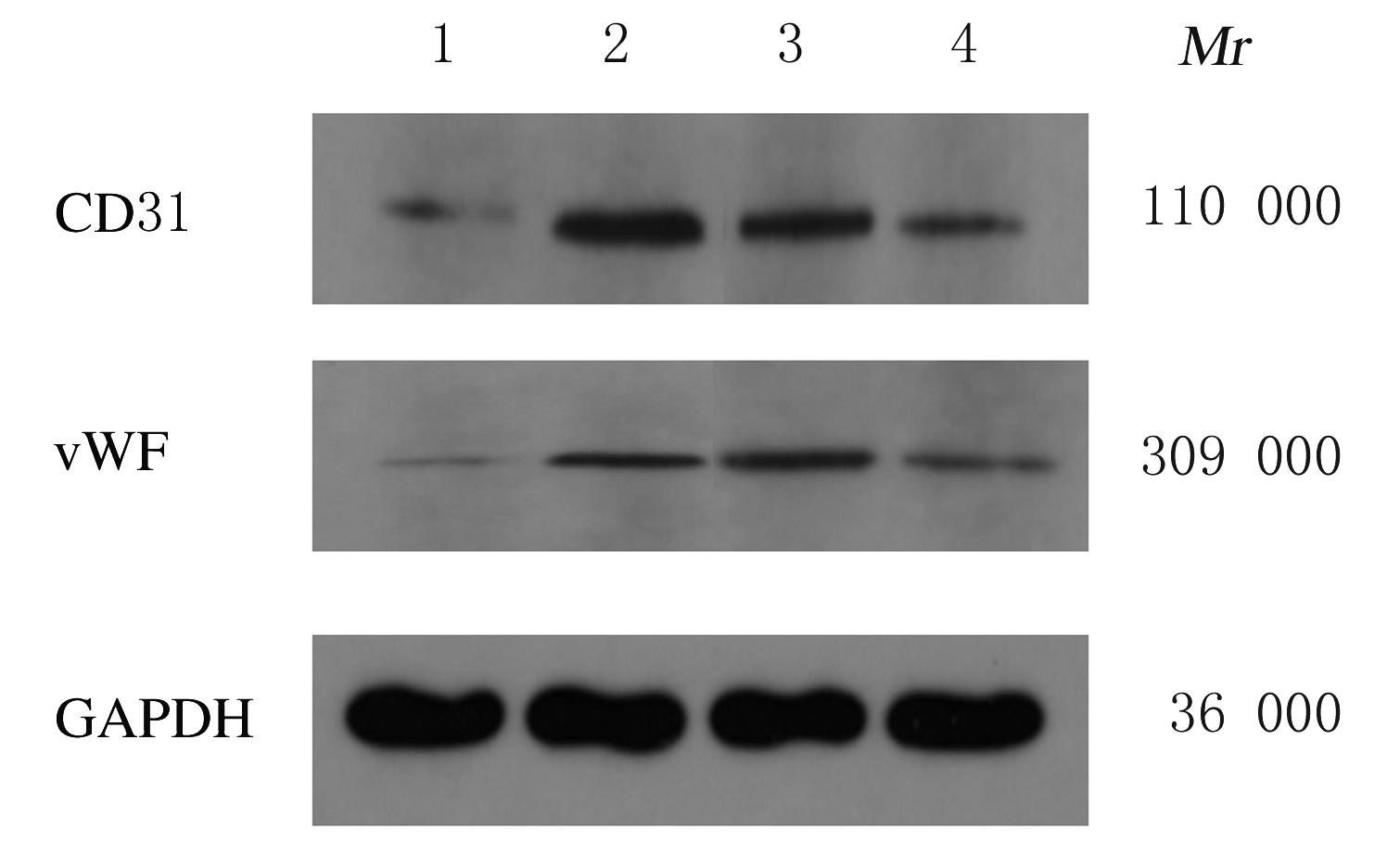Journal of Jilin University(Medicine Edition) ›› 2021, Vol. 47 ›› Issue (5): 1124-1130.doi: 10.13481/j.1671-587X.20210507
• Research in basic medicine • Previous Articles Next Articles
Influence of curcumol in structure of liver sinusoidal endothelial cells of mice and its inhibitiory effect on intrahepatic angiogenesis
Yang ZHENG1,Jiahui WANG1,Yue PENG2,Xianling YUAN2,Lei WANG1,Tiejian ZHAO2( )
)
- 1.Department of Medicine,Faculty of Chinese Medicine Science,Guangxi University of Chinese Medicine,Nanning 530021,China
2.Department of Physiology,College of Basic Medical Sciences,Guangxi University of Chinese Medicine,Nanning 530021,China
-
Received:2021-01-31Online:2021-09-28Published:2021-10-26 -
Contact:Tiejian ZHAO E-mail:570041687@qq.com
CLC Number:
- R657.3
Cite this article
Yang ZHENG,Jiahui WANG,Yue PENG,Xianling YUAN,Lei WANG,Tiejian ZHAO. Influence of curcumol in structure of liver sinusoidal endothelial cells of mice and its inhibitiory effect on intrahepatic angiogenesis[J].Journal of Jilin University(Medicine Edition), 2021, 47(5): 1124-1130.
share this article
| 1 | 谢 婧,李丽华.脱水穿心莲内酯对四氯化碳诱导的肝纤维化模型小鼠肝细胞凋亡的抑制作用及其机制[J].吉林大学学报(医学版),2019,45(5):1009-1014,1193. |
| 2 | 张 弘,陶 森,郝 彧,等.国外肝纤维化诊断的研究热点分析[J].首都医科大学学报,2016,37(1):83-88. |
| 3 | 孙 鑫,刘洪亮,黄 恺,等.虫草菌丝中3种活性成分对血管新生与内皮细胞功能的影响[J].中草药,2017,48(24):5217-5223. |
| 4 | POISSON J, LEMOINNE S, BOULANGER C,et al. Liver sinusoidal endothelial cells: Physiology and role in liver diseases[J]. J Hepatol,2017,66(1):212-227. |
| 5 | MIYASHITA T, NAKANUMA S, AHMED A K,et al.Ischemia reperfusion-facilitated sinusoidal endothelial cell injury in liver transplantation and the resulting impact of extravasated platelet aggregation[J].Eur Surg,2016,48(2):92-98. |
| 6 | WANG L, FENG Y M, XIE X Y,et al. Neuropilin-1 aggravates liver cirrhosis by promoting angiogenesis via VEGFR2-dependent PI3K/Akt pathway in hepatic sinusoidal endothelial cells[J]. EBioMedicine,2019,43:525-536. |
| 7 | 王柳萍,梁灿明,李月儿,等.广西莪术化学成分研究[J].广西中医药,2016,39(2):78-80. |
| 8 | OIE C I, APPA R S, HILDEN I,et al.Rat liver sinusoidal endothelial cells(LSECs)express functional low density lipoprotein receptor-related protein-1(LRP-1)[J].J Hepatol,2011,55(6):1346-1352. |
| 9 | ZENG Y, WANG J, WANG J,et al. Effect of curcumol on the fenestrae of liver sinusoidal endothelial cells based on NF-κB signaling pathway[J]. Evid Based Complement Alternat Med,2020,2020:8590638. |
| 10 | PAROLA M, PINZANI M. Liver fibrosis: Pathophysiology, pathogenetic targets and clinical issues[J]. Mol Aspects Med,2019,65:37-55. |
| 11 | 陈 柳,李 敏,王晓萍,等.肝脏细胞自噬在肝纤维化中的作用研究进展[J].药学研究,2020,39(9):540-544. |
| 12 | MASLAK E, GREGORIUS A, CHLOPICKI S.Liver sinusoidal endothelial cells (LSECs) function and NAFLD;NO-based therapy targeted to the liver[J].Pharmacol Rep,2015,67(4):689-694. |
| 13 | DELEVE L D, WANG X, GUO Y.Sinusoidal endothelial cells prevent rat stellate cell activation and promote reversion to quiescence[J].Hepatology,2008,48(3):920-930. |
| 14 | SU X N, MA X W, XIE X Y,et al. FN-EDA mediates angiogenesis of hepatic fibrosis via integrin-VEGFR2 in a CD63 synergetic manner[J]. Cell Death Discov,2020,6(1):140. |
| 15 | 钟培玲,陈英杰,柳 臻,等.软肝颗粒抑制血管新生的抗肝纤维化作用机制研究[J].中西医结合肝病杂志,2021,31(1):30-33. |
| 16 | 郑 洋,王佳慧,梁天坚,等.莪术醇对肝星状细胞Rho-ROCK信号通路作用的实验研究[J].中国医院药学杂志,2019,39(15):1517-1520. |
| 17 | ROSMORDUC O, HOUSSET C. Hypoxia: a link between fibrogenesis, angiogenesis, and carcinogenesis in liver disease[J]. Semin Liver Dis,2010,30(3):258-270. |
| 18 | 周 丹,张立婷,李俊峰,等.缺氧诱导因子1α在肝纤维化发生发展中的作用机制[J].临床肝胆病杂志,2019,35(7):1604-1607. |
| 19 | 夏雪皎,林庚庭,滕 飞,等.疏肝健脾活血方对肝纤维化大鼠肝组织HIF-1α蛋白及VEGF mRNA表达的影响[J].中华中医药杂志,2018,33(4):1357-1360. |
| 20 | SARANADASA M, WANG E S. Vascular endothelial growth factor inhibition: conflicting roles in tumor growth[J]. Cytokine,2011,53(2):115-129. |
| 21 | 陈兰羽,马继征,刘咏梅,等.基于HIF-1α介导的VEGF mRNA表达探讨膈下逐瘀汤抗肝纤维化血管新生的机制[J].中草药,2019,50(2):449-456. |
| 22 | 许明星,许瑞云,林 楠,等.肝窦毛细血管化研究进展[J].器官移植,2016,7(5):403-406. |
| 23 | 鲁 军,周 凝,黄 棪,等.疏肝健脾活血方对肝星状细胞/肝窦内皮细胞共培养体系中VEGF/VEGFR表达的影响[J].中医杂志,2019,60(3):242-247. |
| 24 | 张 荣,刘绍能,周海艳,等.芪术颗粒对肝纤维化模型大鼠肝窦微血管新生的影响及其机制研究[J].中药新药与临床药理,2019,30(6):659-663. |
| 25 | 吴循循,张才臻,王 馨,等.以血管生成与重构为靶点的肝纤维化治疗研究[J].药学学报,2015,50(5):535-540. |
| [1] | Kexin CHEN,Donghao QU,Xiaolong LIU,Bo CHEN,Shuyan ZHANG. Effect of CD47 knockout on angiogenesis after traumatic brain injury in mice and its molecular mechanism [J]. Journal of Jilin University(Medicine Edition), 2022, 48(4): 839-846. |
| [2] | Junjie HOU,Xuguang MI,Xiaonan LI,Xiaonan LI,Ying YANG,Xianzhuo JIANG,Ying ZHOU,Zhiqiang NI,Ningyi JIN,Yanqiu FANG. Bronchopleural fistula complicated in treatment process of non-small cell lung cancer by bevacizumab combined with paclitaxel: A case report and literature review [J]. Journal of Jilin University(Medicine Edition), 2022, 48(2): 513-517. |
| [3] | Zhouguang WU,Bin WANG,Zhen CHENG,Wenjie ZHANG,Taoyan ZUO,Siqi CHEN,Jingru FU. Analysis on correlation of GPC3 and α-SMA expressions with liver function-related indexes in liver tissue of children with biliary atresia [J]. Journal of Jilin University(Medicine Edition), 2021, 47(5): 1237-1243. |
| [4] | Rongjun JIA,Liman MA,Lihua LI. Protective effect of calcitriol on hepatic fibrosis induced by bile duct ligation in mice and its mechanism [J]. Journal of Jilin University(Medicine Edition), 2021, 47(2): 257-264. |
| [5] | Bo WANG,Yan YANG,Rui FEI,Niancai JING,Zhaodong LI,Yi LU,Hongyu XIAO,Yue ZHANG. Inhibitory effect of Shuganhuazheng Formula on growth of triple negative breast cancer of subcutaneous transplantation in mice [J]. Journal of Jilin University(Medicine Edition), 2021, 47(2): 299-306. |
| [6] | Qi ZHAO,Changhai HE,Zhi WANG,Xuefeng WANG,Xiaofei LIU. Inhibitory effect of ALKBH3 knockdown on growth, migration and tumor angiogenesis of bladder cancer cells and its mechanism [J]. Journal of Jilin University(Medicine Edition), 2021, 47(2): 397-406. |
| [7] | YANG Fan, LI Lihua. Effect of vitamin D receptor activation on hepatic fibrosis induced by bile duct ligation in mice and its mechanism [J]. Journal of Jilin University(Medicine Edition), 2020, 46(04): 722-727. |
| [8] | BU Yi, ZHANG Shuo, QIAN Xudong, WANG Hongmei, DOU Zhijie. Expression of insulin-like growth factor binding protein-3 in ischemic brain tissue of cerebral infarction model rats and its relationship with angiogenesis [J]. Journal of Jilin University(Medicine Edition), 2020, 46(04): 759-764. |
| [9] | BAI Jie, JI Wenjing, DING Yongnian, PENG Yuanyuan, CHEN Yuanwen. Changes of levelsof endogenous AcSDKP and its regulatory factors in liver tissue of model rats with liver fibrosis induced by bile duct ligation [J]. Journal of Jilin University(Medicine Edition), 2018, 44(05): 999-1004. |
| [10] | LI Chun, GUAN Xingang, WANG Yingnan, XU Congrui, GAI Xiaodong. Inhibitory effect of Tum-5 gene on growth of hepatocellular carcinoma cells and its influence in angiogenesis [J]. Journal of Jilin University Medicine Edition, 2018, 44(01): 58-62. |
| [11] | CHANG Caifang, HOU Yong, CONG Gang. Therapeutic effect of α-2b interferon on inflammation of liver tissue and liver fibrosis in hepatitis B model ducks [J]. Journal of Jilin University Medicine Edition, 2017, 43(01): 11-15. |
| [12] | YUN Fen, JIA Yongfeng, HAN Zhao, SUN Qinnuan, LI Xiuxia, YU Huiling. Expression of HIF-2αin non-small cell lung cancer tissue and its relationships with MVD,Ki67,and GST-π [J]. Journal of Jilin University Medicine Edition, 2016, 42(05): 954-957. |
| [13] | HAO Xiaofang, ZHANG Ronghua, WANG Lin, WANG Meimei, ZHEN Yongzhan, ZHANG Guangling, CHEN Jing. Therapeutic effect of rhein lysinate on liver fibrosis in cholestatic model rats and its molecular mechanisms [J]. Journal of Jilin University Medicine Edition, 2015, 41(03): 481-485. |
| [14] | LA Zong,WANG Jian-xia,CUI Ni,LI Ming-yue,XING Shu-gang,REN Bo,ZHANG Li-hong,LI Wei,LI Yu-lin. Correlation of CD4 and CD8 positive lymphocytes with tumor angiogenesis in microenvironment of breast invasive ductal carcinoma [J]. Journal of Jilin University Medicine Edition, 2014, 40(05): 1064-1073. |
| [15] | LIU Hong,XIE Jia,LIU Hao,ZHENG Yue-yong,WU Cheng-yi,QU Hong-bo,LI Cong. Influence of FOXC2 in angiogenesis of breast cancer MCF-7 cells by DLL4/Notch1 signal pathway [J]. Journal of Jilin University Medicine Edition, 2014, 40(03): 488-492. |











